How to Clear RAM on iPhone and What Happens When You Do
When using smartphones, the occasional glitches and crashes become a part of the process. However, the problem starts when the frequency of these issues increases. When this happens, consider clearing the RAM on your iPhone.
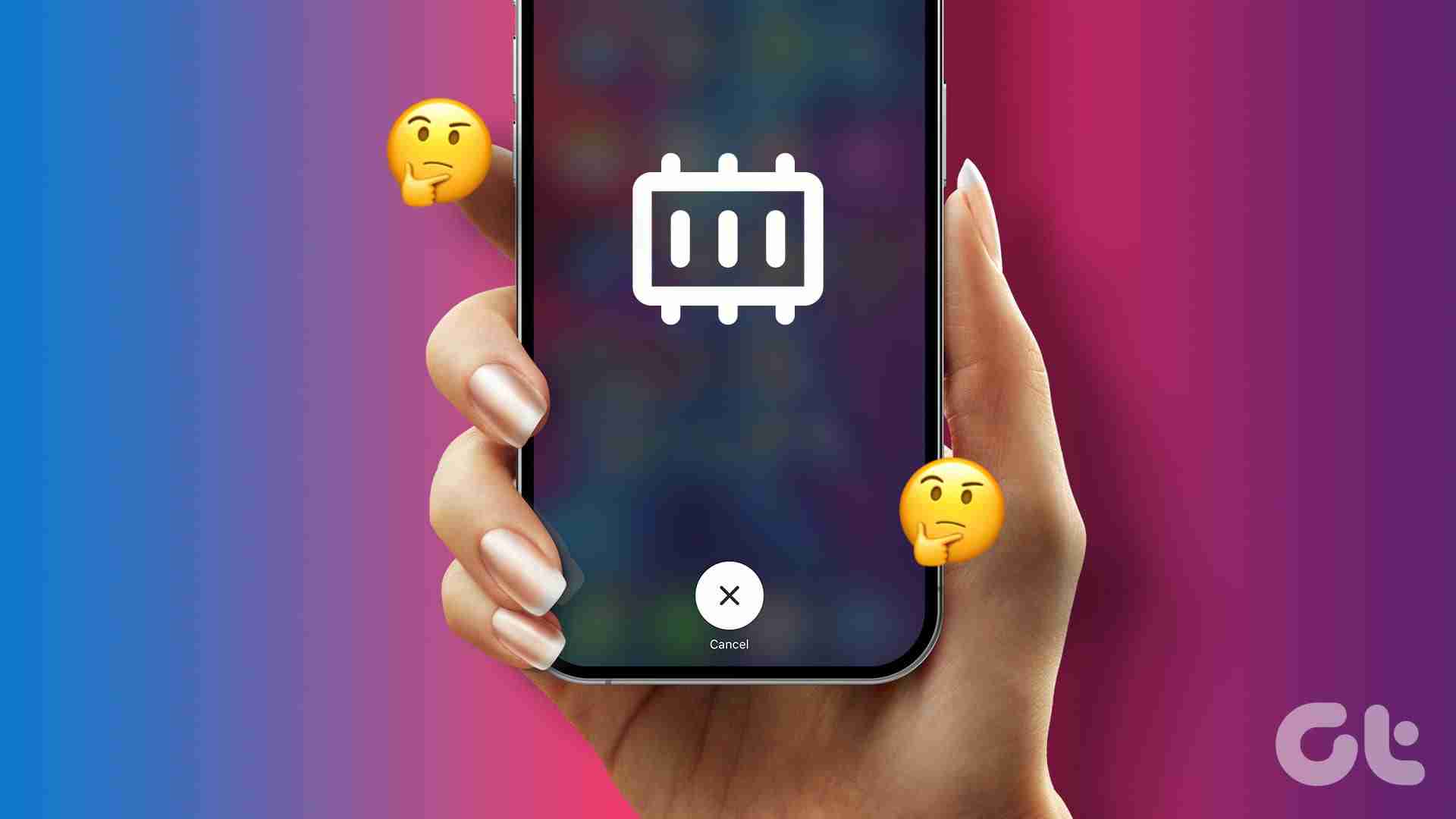
iPhone processes, like background apps, iPhone updates, etc., use your device’s memory or RAM. While iPhones are usually adept at managing their RAM usage, there can be times when these tasks become too overwhelming. When this happens, your device starts to slow down and even freeze. This is when you can take matters into your own hands and manually clear the RAM on your iPhone.
Should You Clear Memory on iPhone and What Happens When You Do
Before we learn to free up RAM on your iOS device, let us quickly look at a few questions about this process to understand why it should be done.
Is It Safe to Clear iPhone RAM
Clearing the RAM on your iPhone is usually a quick and safe process that doesn’t affect your device’s data. However, it is something that you should only do if you have been seeing visible performance issues, lags, and crashes. Otherwise, your iPhone will do this automatically.
Can Clearing the RAM Prolong iPhone Battery Life
While freeing up memory doesn’t impact your iPhone’s battery life per se, it affects how other apps use your device’s resources. This ultimately helps extend your iPhone’s battery life. However, this impact might be negligible, depending on certain other factors.
Will This Stop Apps From Being Unresponsive or Crashing
Usually, yes. This is especially true if you’re restarting the app or soft resetting your iPhone. However, try using other methods to resolve such issues and use the clearing iPhone memory method as your last resort.
Will App Loading Time Increase After Clearing RAM
Clearing the RAM helps free up your iPhone’s memory. This can be used for other tasks, like loading and using the app. This can make the app load faster and, in some cases, improve the overall user experience. This will be more apparent for apps that use more system resources, like gaming apps.
Can This Help Free up Device Storage
If you go for the offloading or uninstalling option, it will remove the app and, in the case of the latter, app data as well from your iPhone’s storage. This will help free up device storage and, through that, improve the memory usage on your iPhone.
How to Free up RAM on Your iPhone
Now that we know more about what happens when you free up RAM on your iPhone, let us look at how you can do it.
1. Using the Settings Menu
If your iPhone has a physical Home button, you can use it to clear the memory on your iPhone. To do that, use the Settings menu to power off your device and press the Home button to finish the process. Here’s how.
Step 1: Open Settings and tap on General.
Step 2: Here, tap on Shut Down.
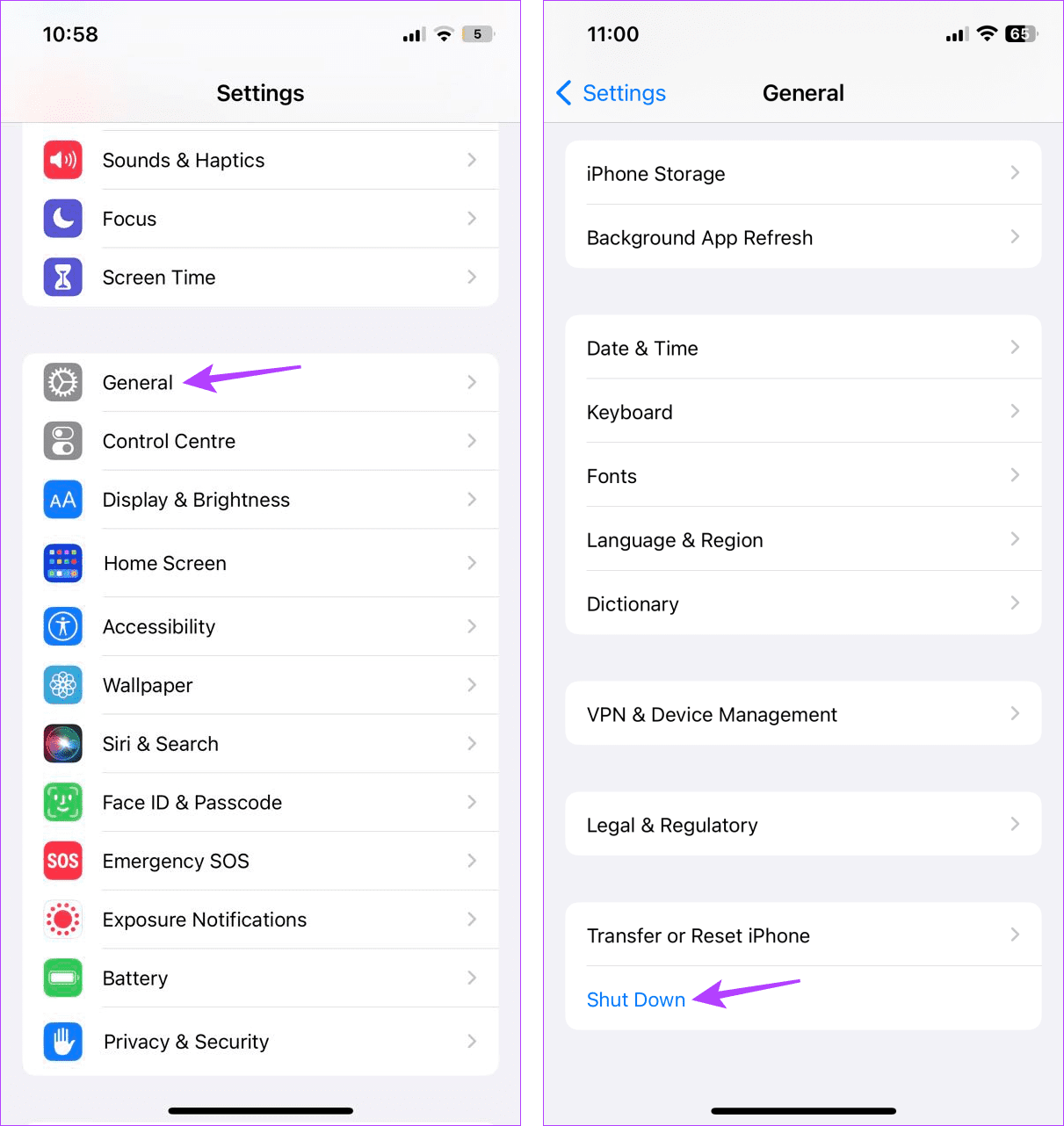
Step 3: Wait for the turn-off slider to appear.
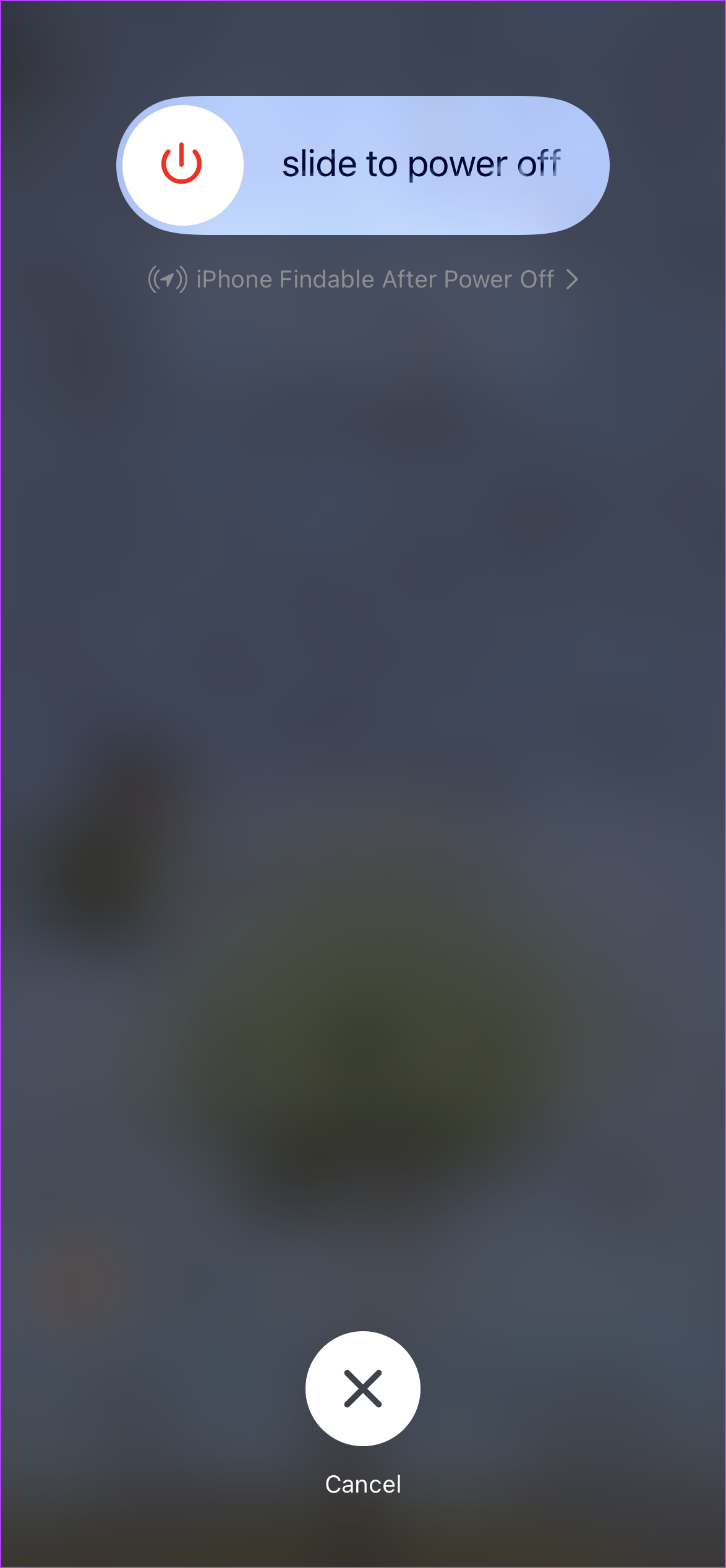
Step 3: Now, long-press the Home button. Wait for your iPhone’s screen to go blank.
Then, release the Home button and, once the lock screen appears, enter the device password to finish the process.
2. Using Assistive Touch
If your iPhone has Face ID available, you can use Assistive Touch to free up RAM on your iPhone. This way, you can use the virtual Home button, especially since your device is not equipped with a physical Home button. Here’s how to do it.
Step 1: Open the Settings menu and tap on Accessibility.
Step 2: Here, tap on Touch.
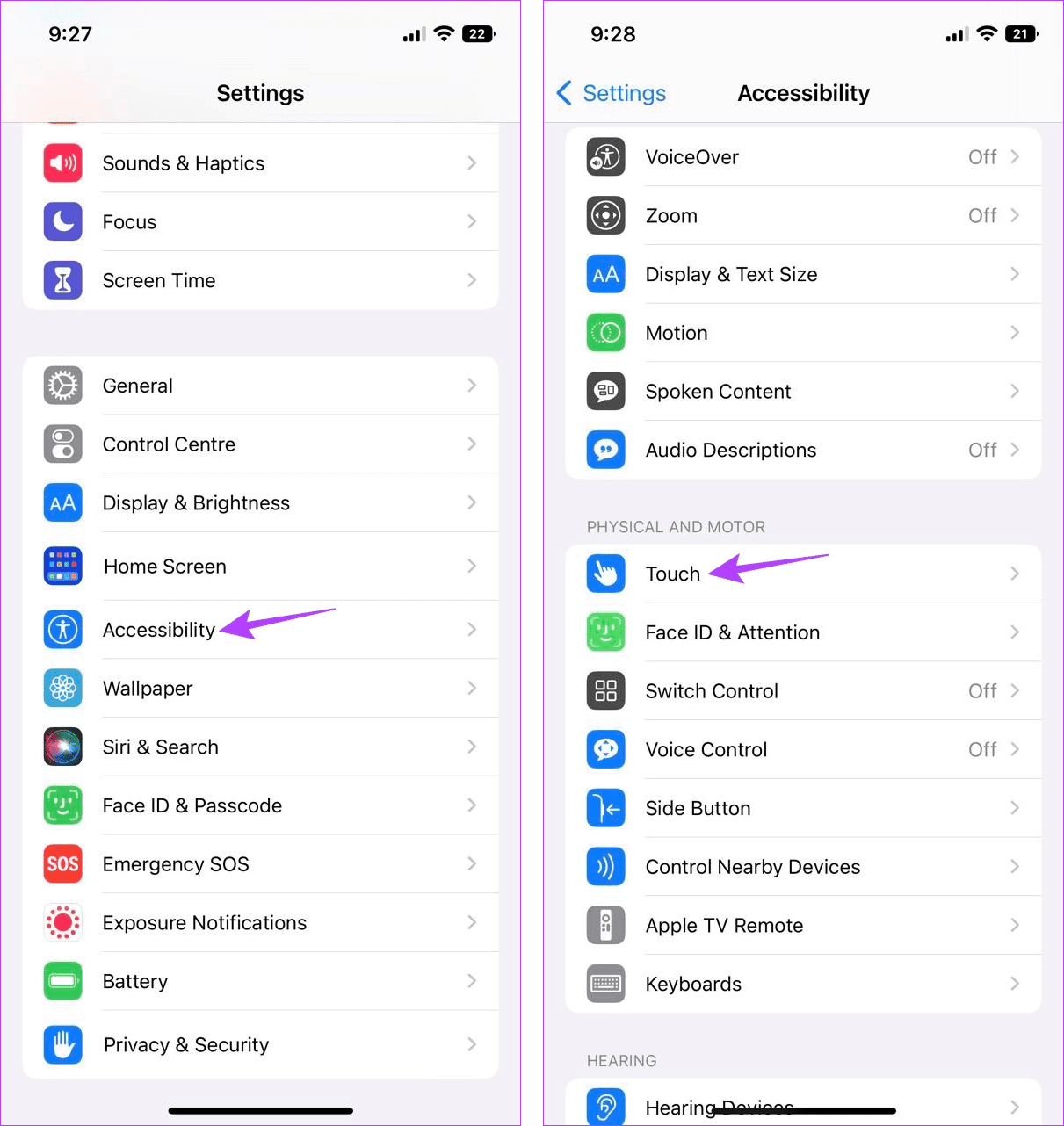
Step 3: Tap on AssistiveTouch.
Step 4: Then, turn on the toggle for AssistiveTouch.
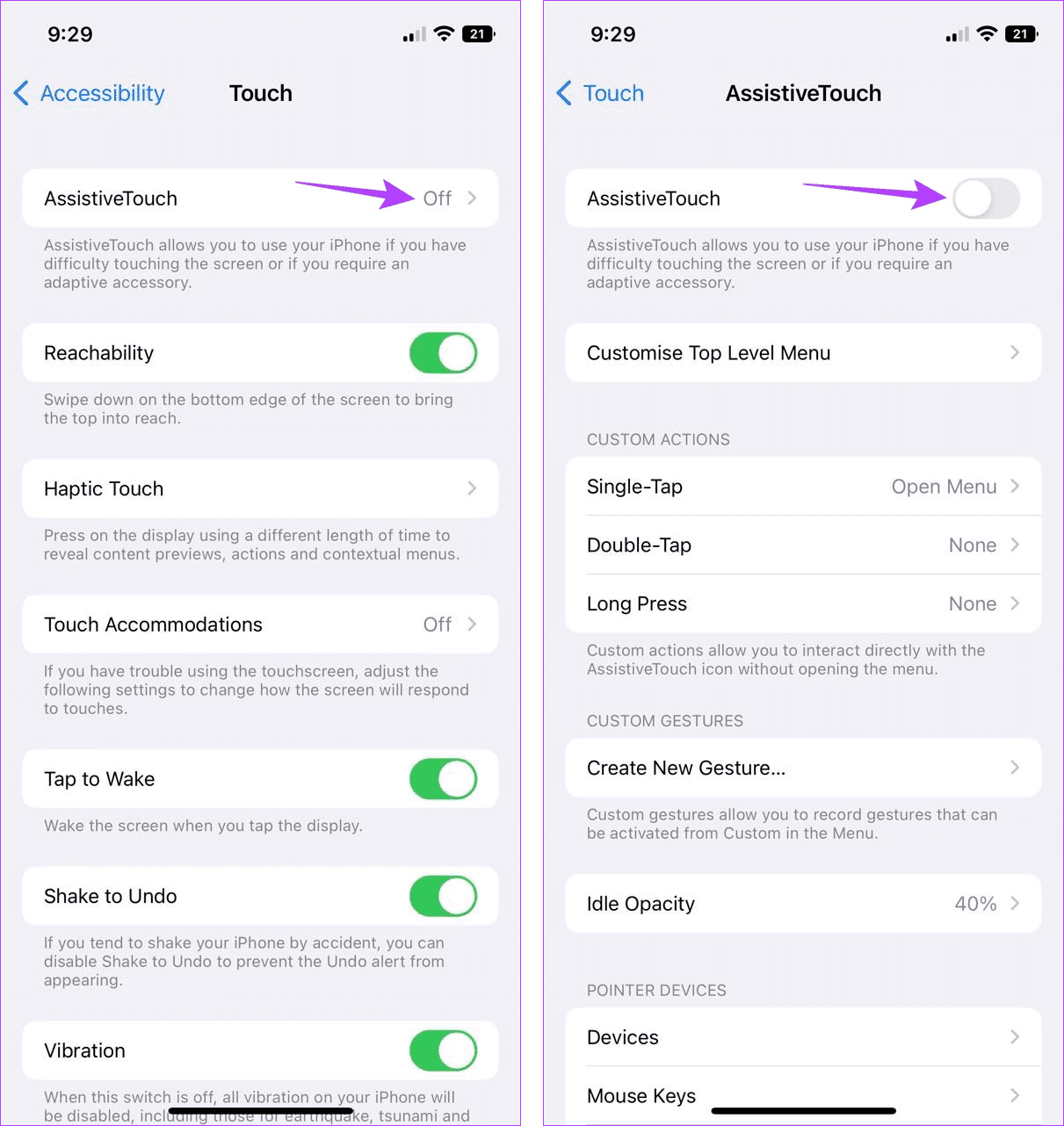
Step 5: Once done, go back to the main Settings page and tap on General.
Step 6: Scroll to the bottom and tap on Shut Down. Wait for the turn-off slider to appear.

Step 7: Here, tap on the AssistiveTouch button to see more options.
Step 8: Then, tap on Home.
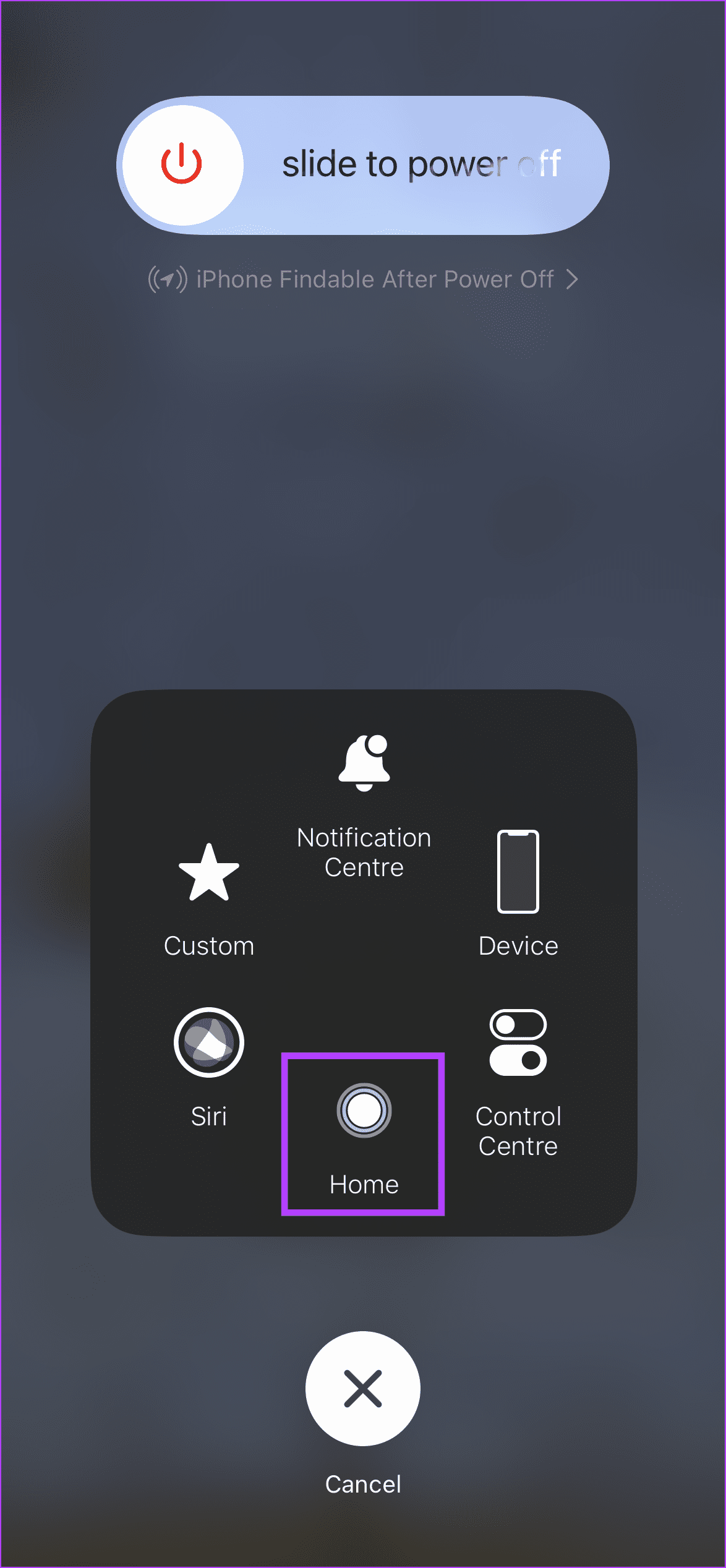
Your iPhone’s screen should briefly flash before returning to the main lock screen. This should have cleared the memory on your iPhone.
Also Read: How to fix AssistiveTouch not working on iPhone
3. Force Closing the App
Leaving apps to run in the background can help you access them quickly. However, these apps actively use your device’s memory to stay awake and operate in the background. So, if you face issues with apps crashing or running slowly, clear all the background apps. Then, start them afresh. This can not only help reduce RAM usage but also fix certain app issues. Here’s how.
Step 1: Swipe up from the bottom of the screen to open background apps. Or, if your iPhone has a Home button, double-press it to do the same.
Step 2: Once the background apps open, swipe up to close them. Go through all the currently visible apps and repeat this process until all apps disappear.

Step 3: Then, tap on the relevant app icons to reopen the apps on your iPhone.
4. Offload Unused Apps
If you have apps not currently in use, you can offload those apps from your iPhone. This will essentially delete the app while still retaining the app data. It is an excellent option for apps that you might use in the future but currently is occupying storage and hogging the RAM by running in the background. Follow the below steps to do it.
Step 1: Open Settings and tap on General.
Step 2: Here, tap on iPhone Storage.
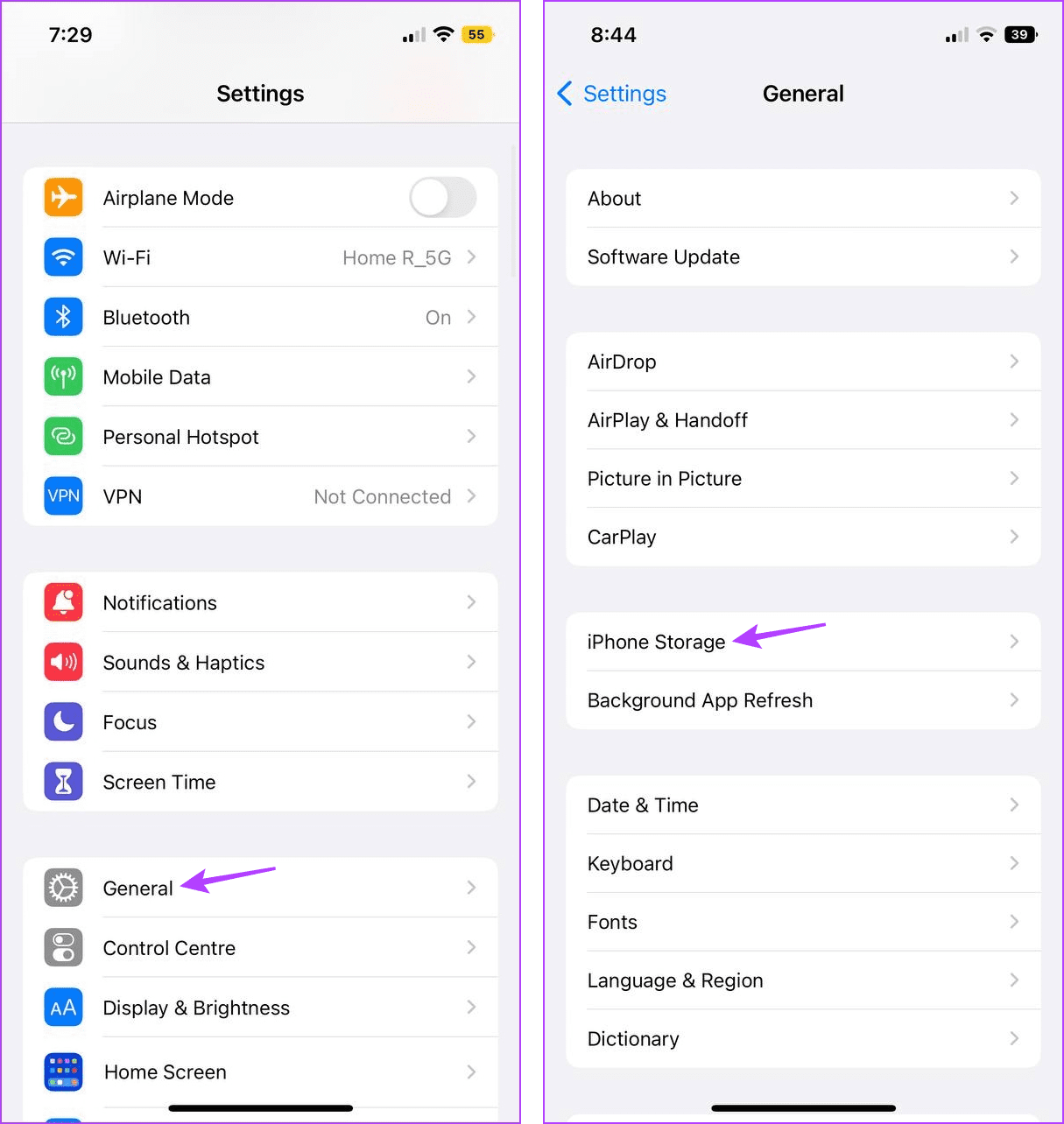
Step 3: Now, scroll through the currently installed apps and tap on the relevant one.
Step 4: Then, tap on Offload App. When prompted, tap on Offload App to confirm.
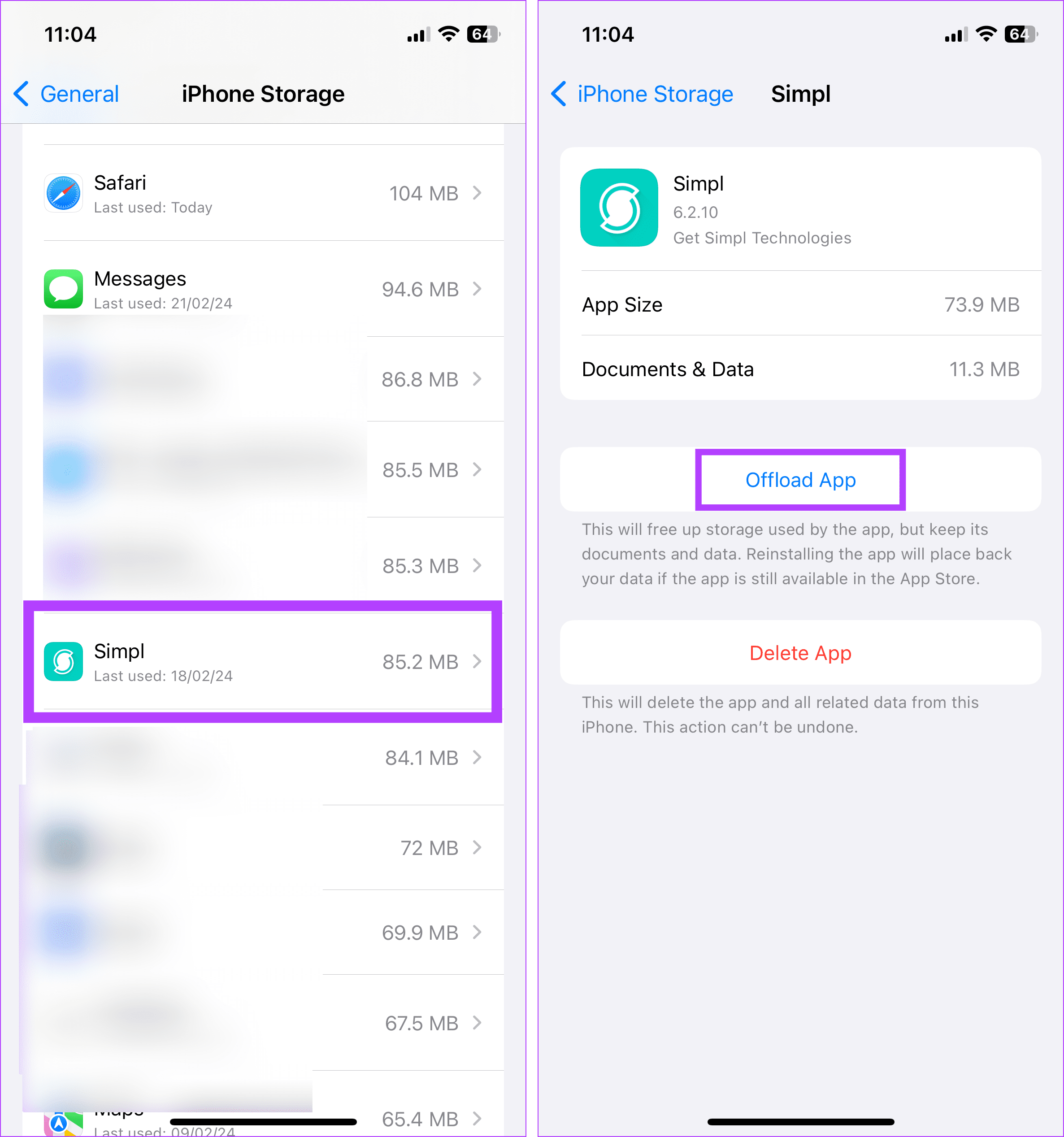
This will offload the selected app. You can also repeat these steps to offload any other apps on your iPhone.
5. Uninstall Excess Apps
Over time, your iPhone becomes a home for multiple apps. This can cause your iPhone’s storage space to become limited or full. Once this happens, all tasks require more memory to process, increasing RAM usage. To reduce this, uninstall the apps no longer required from your iPhone. Here’s how.
Step 1: Go to the relevant app and long-press on it.
Step 2: Once the options appear, tap on Remove App.
Step 3: Here, tap on Delete App. If prompted, tap on Delete.
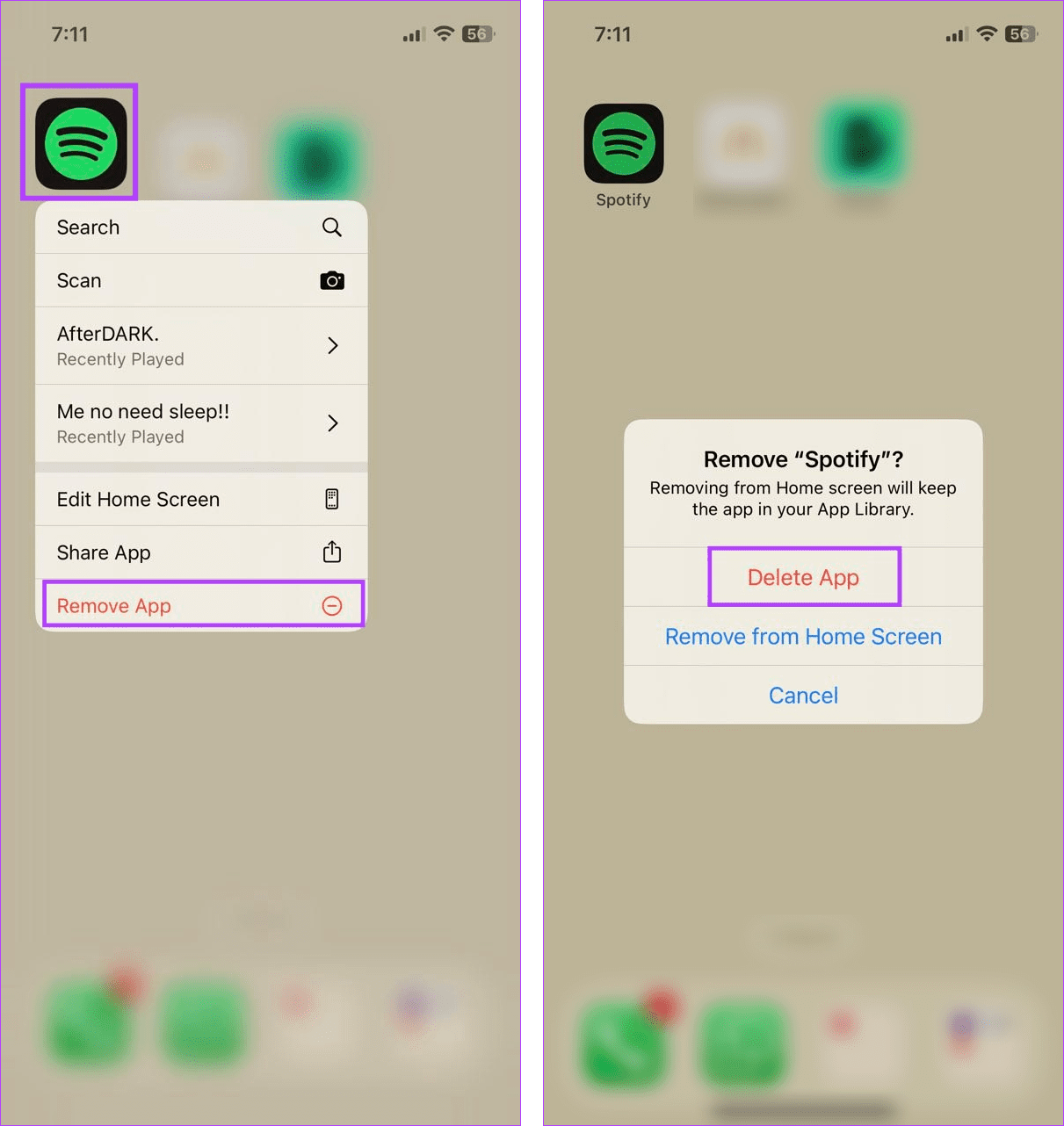
Wait for the app to finish uninstalling. Repeat these steps to uninstall any other unwanted app from your iPhone.
6. Doing a Soft Reset
Different from a complete reset, a soft reset helps you to restart your iPhone forcefully. This will not affect your device’s data but will turn off and restart all device features and functions, ultimately resetting your iPhone’s RAM. Follow the below steps to do it.
On iPhone 8, SE 2nd Gen, and Later:
Step 1: Press and hold the volume up button for a few seconds, then release it.
Step 2: Immediately after, press and hold the volume down button and then release it.
Step 3: In quick succession, press and hold the Side button. Release the button once the Apple logo appears.
On iPhone 7 and 7 Plus:
Step 1: Press and hold the volume down button and the Side button at the same time until the Apple logo appears.
Step 2: Then, release the buttons and wait for your iPhone to restart.
On iPhone 6s and SE 1st Gen:
Step 1: Press and hold the Home button and the Side/Top button at the same time.
Step 2: Wait for the Apple logo to appear. Then, release both buttons.
Wait for your iPhone to restart to finish the process.
FAQs for Reducing RAM Usage on Your iPhone
Yes, you can use certain third-party apps like Smart Memory Lite and System Status: hw monitor to check and clear the RAM on your iPhone. However, to do this, these apps will require access to your iPhone’s system, memory, and other data. This can be risky in the long run, especially if these apps keep a record of your device data.
You can go into the Settings menu and tap on General > About to see how much memory your iPhone currently has. However, other details, like how much RAM is currently being used, might not be available.
Constantly being short on RAM can slow down and, ultimately, crash some processes on your iPhone. When this happens, clear the RAM on your iPhone from time to time. We hope this article helped you understand how to do it. You can also check our guide to learn more about clearing system data on your iPhone.
-
 Fortnite Returns to iPhone, and Finds a New Android HomeFour years after its removal from Google’s and Apple’s mobile stores, Fortnite is now available to iPhone owners in the European Union (EU), and ther...Software tutorial Published on 2024-11-08
Fortnite Returns to iPhone, and Finds a New Android HomeFour years after its removal from Google’s and Apple’s mobile stores, Fortnite is now available to iPhone owners in the European Union (EU), and ther...Software tutorial Published on 2024-11-08 -
 5 Ways to Fix iPhone Showing Incorrect Screen TimeBasic Fixes: Disable and Re-enable Screen Time: If your iPhone screen time report shows the wrong data, you can start by resetting the feature. Simply...Software tutorial Published on 2024-11-08
5 Ways to Fix iPhone Showing Incorrect Screen TimeBasic Fixes: Disable and Re-enable Screen Time: If your iPhone screen time report shows the wrong data, you can start by resetting the feature. Simply...Software tutorial Published on 2024-11-08 -
 5 Ways to Fix Call Failed Error on Apple WatchTry Basic Fixes Contact network carrier: Issues on your network carrier’s end can sometimes cause calls from your Apple Watch to fail. If you’re exper...Software tutorial Published on 2024-11-08
5 Ways to Fix Call Failed Error on Apple WatchTry Basic Fixes Contact network carrier: Issues on your network carrier’s end can sometimes cause calls from your Apple Watch to fail. If you’re exper...Software tutorial Published on 2024-11-08 -
 3 Ways to Check Monthly or Daily Data Usage on iPhoneMethod 1: Check Cellular Data Usage in the Settings App Here’s how you can easily check mobile data usage on your iPhone within the Settings app. Ste...Software tutorial Published on 2024-11-08
3 Ways to Check Monthly or Daily Data Usage on iPhoneMethod 1: Check Cellular Data Usage in the Settings App Here’s how you can easily check mobile data usage on your iPhone within the Settings app. Ste...Software tutorial Published on 2024-11-08 -
 How to Fix Silent Hill 2 Lagging/Stuttering/Low FPS on PCMany gamers have experienced Silent Hill 2 poor performance issues, such as Silent Hill 2 lagging, stuttering, FPS drops, etc. Are you one of them? Th...Software tutorial Published on 2024-11-08
How to Fix Silent Hill 2 Lagging/Stuttering/Low FPS on PCMany gamers have experienced Silent Hill 2 poor performance issues, such as Silent Hill 2 lagging, stuttering, FPS drops, etc. Are you one of them? Th...Software tutorial Published on 2024-11-08 -
 4 Ways to Fix Google Chrome Not Working on Mobile DataBasic Fixes Restart device: Restart your device to fix temporary bugs and glitches. Update Chrome: Update Chrome to the latest version on your device...Software tutorial Published on 2024-11-08
4 Ways to Fix Google Chrome Not Working on Mobile DataBasic Fixes Restart device: Restart your device to fix temporary bugs and glitches. Update Chrome: Update Chrome to the latest version on your device...Software tutorial Published on 2024-11-08 -
 6 Microsoft Teams Status Codes (And What They Mean)Microsoft Teams has various presence “statuses” that users can set to indicate their level of availability. Statuses may also adjust automatically, de...Software tutorial Published on 2024-11-08
6 Microsoft Teams Status Codes (And What They Mean)Microsoft Teams has various presence “statuses” that users can set to indicate their level of availability. Statuses may also adjust automatically, de...Software tutorial Published on 2024-11-08 -
 10 Ways to Fix Call Drop Issue on Samsung Galaxy PhonesWith the latest advancements in calling technology, users can enjoy crystal-clear calls over their mobile network. However, certain users have reporte...Software tutorial Published on 2024-11-08
10 Ways to Fix Call Drop Issue on Samsung Galaxy PhonesWith the latest advancements in calling technology, users can enjoy crystal-clear calls over their mobile network. However, certain users have reporte...Software tutorial Published on 2024-11-08 -
 Galaxy A35 Budget Phone Arrives in US, Gets 5 Years of Security UpdatesThe Galaxy A35 is one of Samsung’s latest budget phones, and last month the company confirmed it was coming to the United States. Now you can actuall...Software tutorial Published on 2024-11-08
Galaxy A35 Budget Phone Arrives in US, Gets 5 Years of Security UpdatesThe Galaxy A35 is one of Samsung’s latest budget phones, and last month the company confirmed it was coming to the United States. Now you can actuall...Software tutorial Published on 2024-11-08 -
 What Is the Location of Windows Firewall Logs: Full GuideThe Windows operating system has a built-in firewall. If logging is enabled for the firewall, files named “pfirewall.log” will be generated in a speci...Software tutorial Published on 2024-11-08
What Is the Location of Windows Firewall Logs: Full GuideThe Windows operating system has a built-in firewall. If logging is enabled for the firewall, files named “pfirewall.log” will be generated in a speci...Software tutorial Published on 2024-11-08 -
 I Would Wear a Galaxy Ring, But Samsung Said NoAs a smart ring wearer, I was excited to see Samsung finally enter the market with a new wearable of its own. But my excitement quickly turned to dis...Software tutorial Published on 2024-11-08
I Would Wear a Galaxy Ring, But Samsung Said NoAs a smart ring wearer, I was excited to see Samsung finally enter the market with a new wearable of its own. But my excitement quickly turned to dis...Software tutorial Published on 2024-11-08 -
 Microsoft OneNote Can Now Straighten Your HandwritingThe feature currently does not support straightening individual words, tables, images, formulas, highlighter ink, or underlines. It also only works f...Software tutorial Published on 2024-11-08
Microsoft OneNote Can Now Straighten Your HandwritingThe feature currently does not support straightening individual words, tables, images, formulas, highlighter ink, or underlines. It also only works f...Software tutorial Published on 2024-11-08 -
 How Can You Clone 500GB HDD to 256GB SSD on Win11/10?Suppose you have a large hard disk with an installed system and data and you prepare a smaller SSD for disk upgrade. Then, you have a doubt: can I clo...Software tutorial Published on 2024-11-08
How Can You Clone 500GB HDD to 256GB SSD on Win11/10?Suppose you have a large hard disk with an installed system and data and you prepare a smaller SSD for disk upgrade. Then, you have a doubt: can I clo...Software tutorial Published on 2024-11-08 -
 How to Clear RAM on iPhone and What Happens When You DoWhen using smartphones, the occasional glitches and crashes become a part of the process. However, the problem starts when the frequency of these issu...Software tutorial Published on 2024-11-08
How to Clear RAM on iPhone and What Happens When You DoWhen using smartphones, the occasional glitches and crashes become a part of the process. However, the problem starts when the frequency of these issu...Software tutorial Published on 2024-11-08 -
 USB Flash Drive Overheating | Potential Causes and SolutionsDoes your USB drive get hot when you use it? What causes USB flash drive high temperature and what will happen if you encounter “USB flash drive overh...Software tutorial Published on 2024-11-08
USB Flash Drive Overheating | Potential Causes and SolutionsDoes your USB drive get hot when you use it? What causes USB flash drive high temperature and what will happen if you encounter “USB flash drive overh...Software tutorial Published on 2024-11-08
Study Chinese
- 1 How do you say "walk" in Chinese? 走路 Chinese pronunciation, 走路 Chinese learning
- 2 How do you say "take a plane" in Chinese? 坐飞机 Chinese pronunciation, 坐飞机 Chinese learning
- 3 How do you say "take a train" in Chinese? 坐火车 Chinese pronunciation, 坐火车 Chinese learning
- 4 How do you say "take a bus" in Chinese? 坐车 Chinese pronunciation, 坐车 Chinese learning
- 5 How to say drive in Chinese? 开车 Chinese pronunciation, 开车 Chinese learning
- 6 How do you say swimming in Chinese? 游泳 Chinese pronunciation, 游泳 Chinese learning
- 7 How do you say ride a bicycle in Chinese? 骑自行车 Chinese pronunciation, 骑自行车 Chinese learning
- 8 How do you say hello in Chinese? 你好Chinese pronunciation, 你好Chinese learning
- 9 How do you say thank you in Chinese? 谢谢Chinese pronunciation, 谢谢Chinese learning
- 10 How to say goodbye in Chinese? 再见Chinese pronunciation, 再见Chinese learning

























